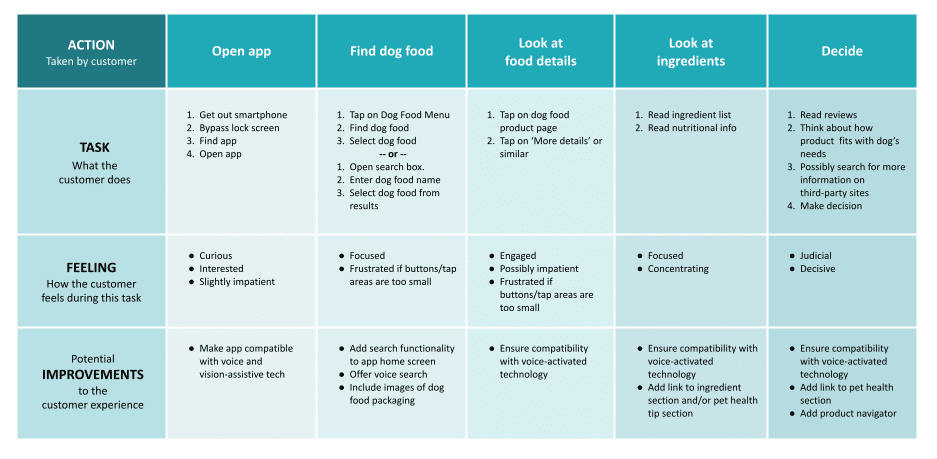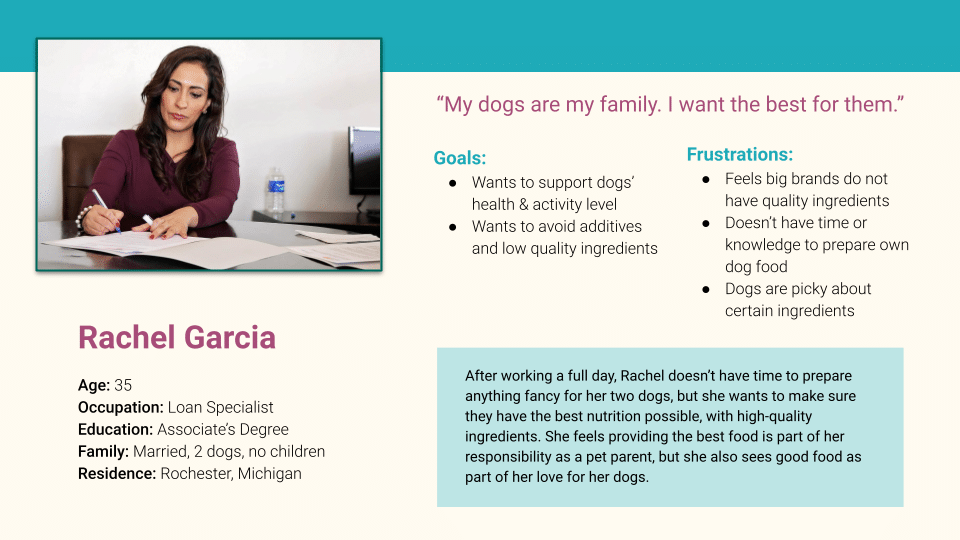In Part 1 of this two-part series, we discussed why it’s important to understand the customer journey and its different stages. In this part, we’ll explain how to build a customer journey map that will help you connect meaningfully with your customers – no matter where they are in their customer journey.
Before we discuss the customer journey map, let’s quickly review our knowledge of the customer journey. A customer’s journey is all of the interactions they have with your brand – before, during, and after a purchase. Understanding what the customer needs at each stage of their journey is essential to creating a great customer experience.
A Quick Review of the Customer Journey
In general, the customer journey can be broken into the following stages:
- Awareness. The potential customer realizes they have a need; they start educating themselves on it. At this stage, people are most likely to be looking for general information rather than solution-specific details.
- Consideration. The potential customer has narrowed their search down to a few main contenders and is deeply researching your company’s solution. At the beginning of this stage, they’re not ready to make a decision; by the end of it, they’ll be ready to move to the next stage.
- Purchase. The customer has made their decision and initiated the purchase process.
- Post-purchase. After the purchase, the customer may need ongoing support or education; they may decide to make another purchase from your company. This is also where customer service comes into play as problems are resolved.
- Loyalty. After several successful interactions with your brand, the customer starts telling others about their experiences. They’re loyal customers and brand advocates.
Obviously, the information and type of interaction that the customer needs in the Consideration stage will be very different from what they need in the Loyalty stage. So it’s not uncommon for businesses to map out customer interactions at various stages and for various customer groups.
This brings us to our first question:
What Is a Customer Journey Map?
A customer journey map is simply the visual representation of a customer’s journey towards an end goal. This goal could be making a purchase, performing a task (e.g. researching items in an online store), or completing an interaction with your company (e.g. calling customer service to follow up on a late order). In short, it’s a great way to learn where you can connect what you’re providing with the customer’s intentions and needs.
You’ll often see customer journey maps displayed as tables, flow charts, paths, and other common diagrams. There are different types of customer journey maps, including service blueprints, a day in the customer’s life, and current state (i.e. what the customer is doing, thinking, and feeling during a particular part of their journey). The current state map is the most common and it’s what we’ll focus on in this article.
Why Create a Customer Journey Map?
Because business owners and employees are so familiar with the product or service they offer, it can be hard to appreciate exactly how customers think and feel as they move through their journey.
A customer journey map helps us understand that journey from their perspective; it can also surface areas of improvement in the customer experience. This can help us optimize both the customer experience and the behind-the-scenes processes. It can also help us stay human-focused and customer-centric as we make decisions. And, as we’ve mentioned numerous times in this series, it can ultimately help us connect with our customers.
What Do You Need to Create a Customer Journey Map?
In a word, research. Lots and lots of user and customer research. Some of this you may already have, such as customer feedback cards, online surveys, and information from your data or web analytics tools. Other research you may need to perform or commission, such as user testing.
When you research, remember the human element. This comes into play in two ways: talking to customer-facing teams and employees (i.e. sales, customer service/support) and, critically, to the customers themselves. When you talk to customer-facing teams, focus on the problems users are trying to solve with your product and how they are using it. You can also ask about features: what users love, what they want to improve or add, and what they don’t use or find inefficient.

Photo by Christina Morillo
The same information can be asked of customers. However, be sure to capture not only what they do (e.g. use a word processing program to create a letter) but why they have to do that task and how it makes them feel. You’ll especially want to find out:
- How customers initially learned about your company (internet search, referrals, etc.).
- How easy your site, app, or store is to use.
- What they’re thinking about during various touchpoints.
- How they feel during various parts of their experience.
Eventually, patterns will emerge. You’ll take this research and create groups of customers with similar behaviors and circumstances. Then you’ll make one persona for each shared major behavioral trait. This persona will be a mini-bio of a fictional person with all the traits of that customer group. Here’s an example of a customer persona:
Notice that the persona includes information about what the customer thinks and feels as well as their goals. You’ll take this information and use it to make your journey map.
Parts of a Customer Journey Map
Let’s revisit our customer journey map. It’s the journey for Rachel Garza, a fictional pet parent who needs to exclude certain ingredients from her dogs’ diets.
Across the top, you’ll see key actions. (This can change depending on the type of customer journey map you’re making. If you’re mapping the buying journey, this would be replaced by key stages in the customer journey, such as Awareness, Consideration, Purchase, and Post-Purchase). In this case, we’re focused on Rachel’s actions as she moves through the app to eventually make a purchase.
Underneath each action, there is a list of tasks that Rachel must do to complete the action. To complete the first action (open the app), Rachel has to take out her smartphone, unlock it, then find and tap the app. Understanding what the customer is doing at each phase of their journey can help you understand the type of content they need and how to best deliver it.
Next, you’ll see some feeling adjectives that describe how Rachel feels or what she thinks while she’s engaged in that action. For example, Rachel might be curious and interested in what the app will tell her, but slightly impatient as she waits for it to load.
Analyzing this, we see some potential issues with Rachel’s customer journey. She might have problems with the app loading. Or perhaps her hands are full and she needs voice recognition to complete the task. Thus, we see some opportunities for improvement. What can we do to solve this issue for Rachel? How and why will we do it? The last row shows some ideas:
As you can see, a customer journey map is really an exercise in empathy. It shifts our perspective from our product, our company, and our goals to what the customer needs and feels. As such, it performs a valuable service. Let’s see how you can create your own customer journey map.
A Step-by-Step Guide to Creating a Customer Journey Map
Let’s suppose you’ve done all your research and you have your customer personas. What’s next?
1. Define your goals and objectives
Figure out what part of the customer journey you want to capture and what map will best suit your purposes. You can grab customer journey map templates at Hubspot, Mural, and all over the web; look around and see what works for you. Some templates and mapping guides may have slightly different details, but the process will be basically the same.
2. Identify Your Target Audience
At first, you’ll probably be mapping the major points of your customer journey. Start with one or two personas that represent the majority of your core audience and build one map per each persona. Refer to your research and think about where the customer will have this experience, how they will feel, what they will want to accomplish, and what might prevent them from moving smoothly through that task.
3. Map Out Customer Interactions
Remember, interactions can happen in the physical or the digital world, and they can cover multiple channels. For example, if you’re mapping out part of the Awareness journey, your customer’s first contact could be from social media.
4. Highlight Key Moments in the Customer Experience
This is pretty self-explanatory. You don’t need to capture every single keystroke (unless you’re doing a user journey map for an app or software program). As you put yourself in the customer’s shoes and immerse yourself in your research, impactful and meaningful moments in the journey will begin to stand out.
5. Incorporate Customer Feedback and Analyze Results
Go back to your customer-facing teams and ask them to validate the accuracy of your map. Did you miss anything? Is something inaccurate or in the wrong place?
You’ll also want to validate your map against customer feedback. You can get this feedback explicitly through surveys or implicitly by analyzing their interactions. When possible, talk directly to your customers; this will help you spot problems you might never otherwise notice.

Photo by Rebrand Cities
Finally, analyze the information in your customer journey map in light of your teams’ and customers’ feedback. For example, if there’s a problem with slow returns or completing sales, take a look at the process. Are there too many touchpoints? Could it be simplified for the worker or the customer? Your customer journey map can help clue you into what’s really going on.
At intervals, take your map back to customer-facing teams and have it checked for accuracy. Does it still correctly represent the customer journey? Are there new issues that need to be introduced? Review it after any major changes – i.e. releasing a new product, redesigning your website or online store, etc.
Customer Journey Map: An Essential Part of Your Process
To recap, understanding the customer journey is critical to providing a great customer experience. But as business owners, managers, and employees, we can be too close to the product/service and our own processes to really grasp what the customer lives through on each part of their journey. A customer journey map helps us visualize what each group of customers needs at a certain point in their journey with us. It helps us build empathy and find areas for improvement. And that is the very core of human-centric business.





